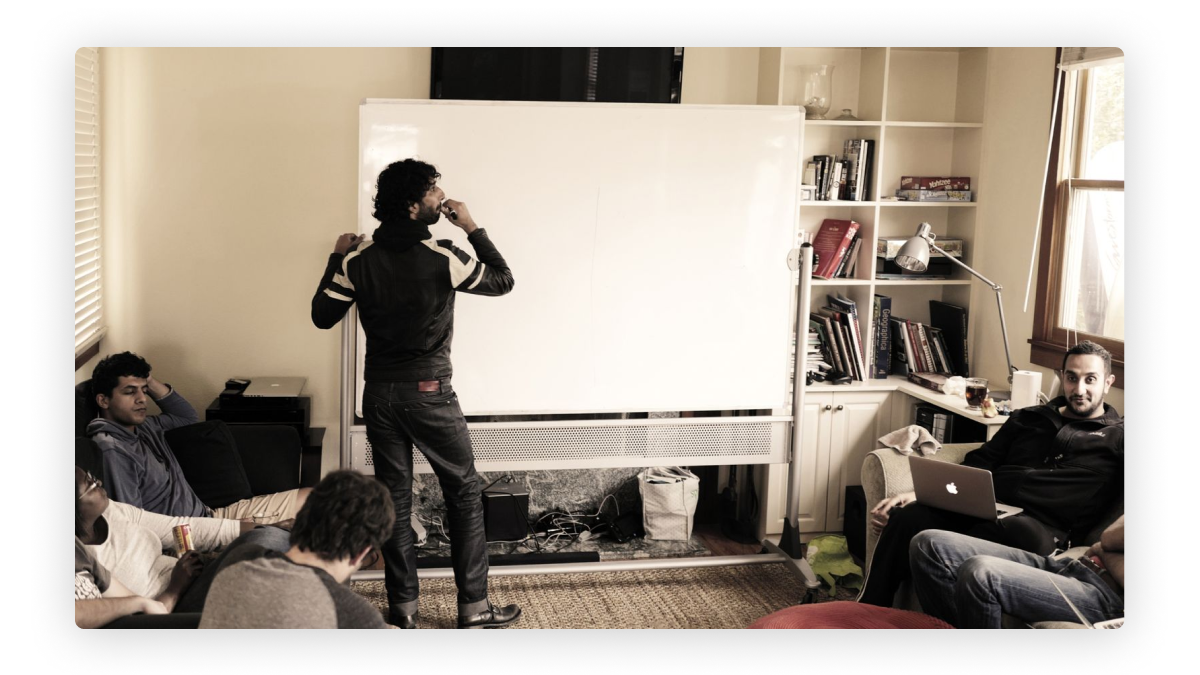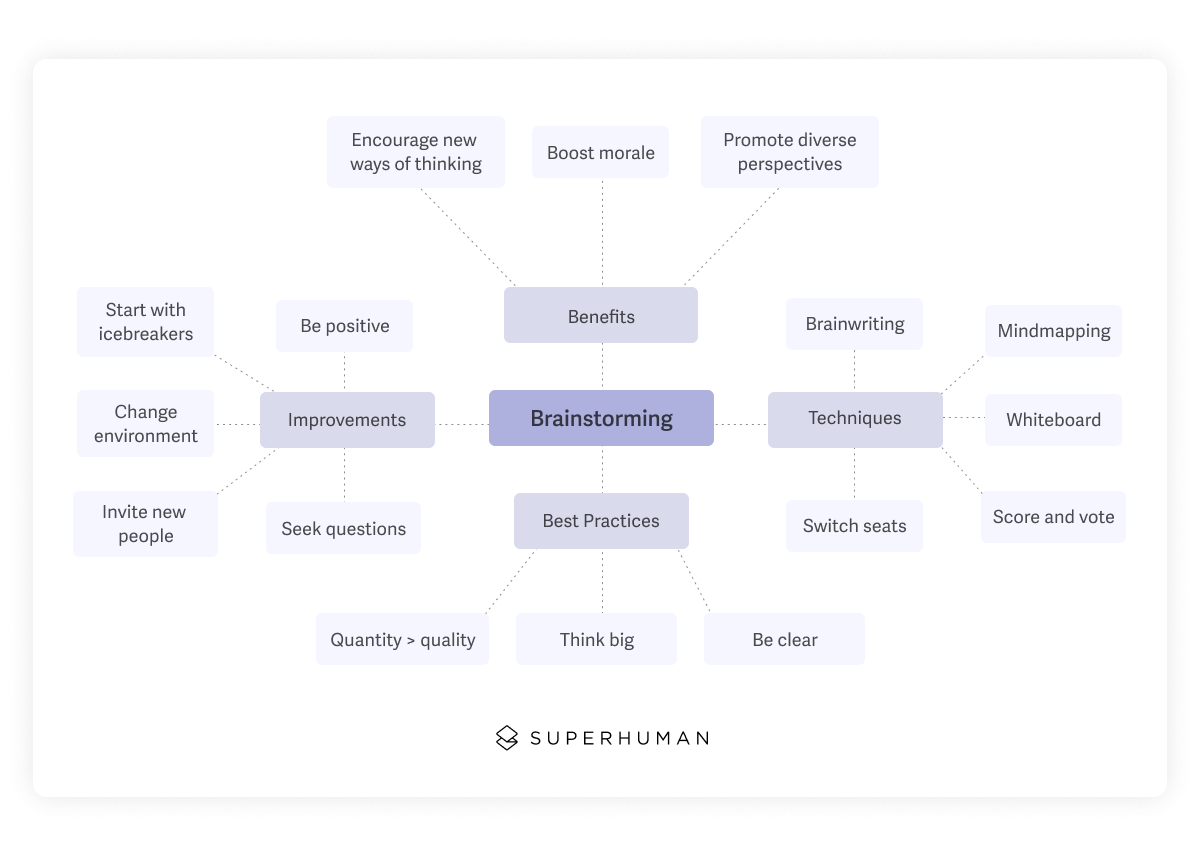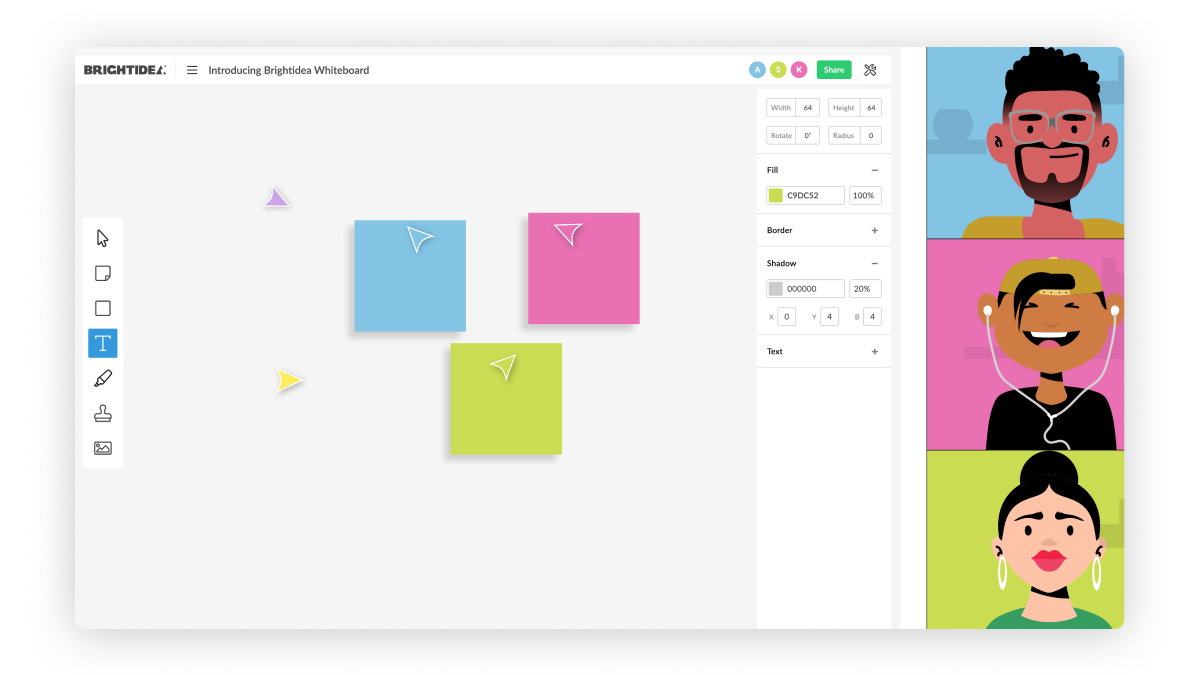
Can you unlock creativity on demand?
I believe you can – if you prepare.
At Superhuman, our best ideas come from brainstorming sessions. I've led many brainstorms – and we have generated as many as 500 ideas in a single session.
When done right, these are the most productive meetings a company can have. They nurture teamwork, encourage different perspectives, and flesh out new ways of thinking about tricky problems.
There's no better feeling than leaving a productive brainstorming session — buoyed by a flurry of creative ideas, and excited for how you'll put them to use.
Here are my tips on how to get there…
Why are so many brainstorming sessions unproductive?
If what I just described sounds like a lofty ideal, you're not alone. There are plenty of ways brainstorming sessions can go off the rails:
- Unbalanced conversation. Brainstorming meetings can be dominated by talkative extroverts, while more reserved team members — introverts who may have stellar ideas — don't feel comfortable chiming in. A similar dynamic can apply to company hierarchy: sometimes less experienced employees don't feel as empowered to contribute as senior execs.
- Lack of preparation. Remember that last long, awkward silence at a brainstorm? It's probably because team members didn't prepare. Maybe they didn't even know how to, because the facilitator never provided a clear roadmap.
- Harsh criticism. Brainstorming, at least for starters, is all about out-of-the-box, non-judgmental thinking. If you shoot down too many ideas too early on, you run the risk of discouraging team members from contributing.
- Meandering focus. Tangents can be helpful, but sessions can stray off topic for too long if the agenda is unorganized and objectives are murky.
- Pleasing the boss. Team members may withhold more ambitious, counterintuitive ideas in favor of more feasible or immediately actionable ones they think the boss will like better.
- The anchoring effect. Brainstormers rely too heavily on the first few ideas brought up, even when better ones arise later on.
- The "real work" fallacy. Employees can come to resent brainstorming sessions, because they distract from the "real" items on a to-do list.
What are the traits of an effective brainstorming session?
On that last point: while there are plenty of ways to gum up your brainstorm process, it's a mistake to think of it as a distraction from "real work".
What may come off as spitballing in the moment can activate countless ideas, solutions, and workflows. Here's how to maximize creativity during a brainstorming session...

Know your goals
While sessions themselves can be flexible, objectives should be specific — both within the session and during follow-up. Facilitators should put goals in writing as a reference point.
Be clear about the input you want
Different brainstorming techniques work for different teams. That's why facilitators should structure sessions to suit their audience's needs and strengths. For example, a "brainwriting" approach (more on this later) may work better for newer team members who don't know each other well.
What's more, a brainstorm is often only as impactful as the questions that steer discussion. Facilitators should always aim to pique curiosity, all while encouraging group members to speak up.
Focus on quantity, not quality
It's rumored that Franklin Delano Roosevelt once said that Winston Churchill came up with 100 ideas a day, but only 4 of them were good.
Sure, that's a bad batting average for baseball. But 4 standouts in a single day is a smashing success for ideation! The bigger the sheer number of ideas you generate, the better chance teams have of landing on a winner.
Think bigger, later
When brainstorming ideas, it's helpful to distinguish the feasible from the original.
At the Air Force Academy, Brian Johnson and Chris D'Lauro conducted a study that showed that when people are asked to pick the single best idea in a brainstorm, they pick a practical, unoriginal one brought up early in the meeting (there's that anchoring effect).
But when they were asked to pick an original idea, it was picked later on in the meeting. Both types of ideas are important — but the most exciting and ambitious ideas grow with patience.
8 tips for improving your brainstorming sessions
If your brainstorming sessions need a makeover, here's what you should do, and why it works.
1. Alter your environment
Research has found two social-psychological conditions that stimulate ideas: dynamism and freedom.
Move to a location that inspires these feelings – a different part of your home office, a backyard tent, or a cabin in the woods. If your team is joining over Zoom, encourage them to do the same.
2. Invite plastic and divergent thinkers
Psychologists have identified 2 personality traits that predict idea generation and originality: "plasticity" and "divergence". Plasticity means high openness and extraversion, whereas divergence means high non-conformity and impulsivity.
Which members of your team approach problems from a unique angle, or give you challenging feedback? You need them at your brainstorm.
3. Start with icebreakers
Jesse Armstrong, the head writer for HBO's TV series, "Succession", starts the show's writing days by going around a conference room and asking every staff writer what they did the night before.
Answers are often boring and mundane. But not only did it help bond the writing staff, who grew to love the ritual, the writers also managed to incorporate some of this chit-chat into the show's DNA.
Therein lies the power of icebreakers. They can warm people up and get team members feeling comfortable with each other. But they can also cultivate deep, focused brainstorming work without a group even knowing.
4. Work with a neutral, experienced facilitator
You don't need to hire a professional facilitator to mediate your brainstorm (though some companies do). What matters is that the session is governed by a discussion leader who's experienced, neutral, and encouraging.
5. Encourage ideas with positivity
There is a common catchphrase at brainstorming sessions: "there's no such thing as a bad idea!"
The reason is simple: a positive environment amplifies our ability to think creatively. And a leader's positivity directly impacts team performance.
Of course, many ideas in a brainstorm will be…not the best! That's expected and perfectly fine. Just say "yes, and…" to build on them and keep the ideas flowing.
6. Moderate motivational intensity
Motivational intensity is how strongly we want or do not want something.
High motivational intensity narrows thinking, whereas low motivational intensity broadens thinking. This is why we often solve problems shortly after we stop thinking about them.
To moderate motivational intensity, keep the atmosphere pleasant and relaxed. Don't create a sense of urgency, or put individuals on the spot.
7. Reframe the challenge with constraints
Add constraints, then rapidly take them away. This engages the part of our brain that autonomously solves problems.
Let's say that you want your startup to make $1M in 2022.
Add constraints: What if you had only 2 months to meet that goal? What if you had to do it with half your team? And what if you had to do it without spending any money at all?
Remove constraints: What if you had 5 years to do it? What if you had a team of 1,000 people? And what if you could spend infinite money to achieve your goal?
8. Seek questions, not answers
Another tactic: brainstorm for questions, rather than answers.
For example, stop asking "how do we make $1M in 2021?" Instead, come up with related questions:
- "Why do we want to make $1M in 2022?"
- "What's the most daunting thing about this goal?"
- "How do we think our competitor would approach this?"
This technique helps attendees push past cognitive biases and see the challenge in a new light.

7 brainstorming techniques to bolster your creative ideas
Now that you know what to strive for (and what to avoid) in your group brainstorm, let's pivot to some tried-and-true techniques. Find which methodology is best for your creative process. And keep in mind that these all work just as well in person as they do over virtual workspaces, which you can enhance with the help of online brainstorming tools.

1. Brainwriting
Team members may prefer writing down an idea before expressing it verbally. In this brainstorming technique, participants spend 5 minutes writing down their own ideas based on a prompt from a facilitator. Then they pass their notes to another team member, who uses those ideas as a jumping off point for other ones.
2. Mind mapping
This technique gives brainstorming a visual component. Group members draw a circle around an idea, and then draw an interconnected web of other thoughts that trickle out of it.
Mind mapping bolsters "yes, and..." creative thinking, because it shows how one OK idea can be the perfect springboard for countless stellar ones.
3. Whiteboard
This brainstorming method involves arranging (then rearranging) sticky notes or index cards on a whiteboard or bulletin board. It's meant to structure brainstorming sessions by separating out questions, goals, and tasks — giving every team member the chance to pin an idea to the corresponding category. It's a productive way to get the entire group involved.
Whiteboarding is also easily replicable for virtual sessions with brainstorming software — take Brightidea and Miro — which come with whiteboard templates (in addition to brainwriting and mindmapping).

4. Stimulate ideas with the "switch method"
Anyone in the room can yell "switch!" any time they feel the energy getting stale. Everyone should then stand up, move around briefly, or change seats. Simply walking increases creative output by 60%.
5. Refine team members' ideas with a ranked-choice vote
Say you have a long list of ideas. How do you find the game-changers?
Triage ideas with a ranked-choice vote. Give each person a virtual $100 in voting currency, and ask everybody to "invest" in the ideas they think are best.
This engages your team with the prioritization process. And you'll see which ideas have the most currency, quite literally.
6. Score ideas by cost and impact
After the brainstorm, the decision-maker steps in.
The decision-maker is the subject matter expert who is accountable for the outcome. In a startup, this is often the team leader or CEO.
The decision-maker then assigns a cost and impact to each idea. Each dimension is rated as low, medium, or high. I sometimes add my own confidence rating in these rankings, and identify risks up-front.
7. Prioritize low-cost, high-impact ideas
Once you have estimated cost and impact, you'll see the most important ideas.
Feed some high-impact, high-cost ideas into your long-term plans. These ideas often reveal gaps in team and strategy.
Prioritize some high-impact ideas with a low or medium cost into your near-term plans. These ideas often reveal ways to quickly improve a product or service. For example, in our 2017 brainstorm, we came up with "Pinned Labels". A few months later, this became "Split Inbox". Today, it is one of Superhuman's most loved and powerful features!
Get started with SuperhumanGetting the most out of your team's brainstorming sessions
With the right preparation, brainstorming is the most productive way to spend company time.
Of course, it's easy to lose focus, with distractions like a hyperactive inbox threatening to cloud your creativity. Superhuman can help reorient your focus from time-sucking emails toward your next brainstorm — get started right here.




